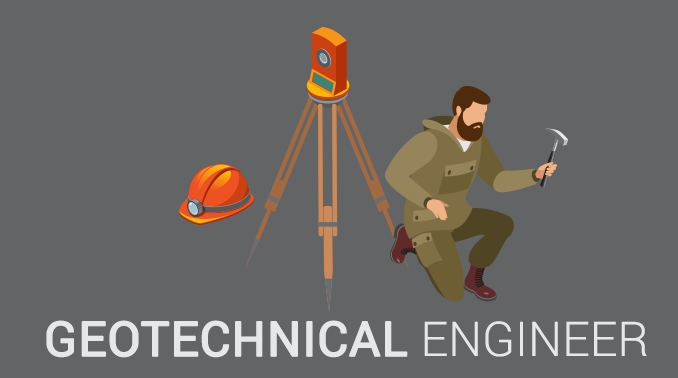The Greatest Guide To Geotheta
The Greatest Guide To Geotheta
Blog Article
Getting The Geotheta To Work
Table of ContentsSome Known Factual Statements About Geotheta Some Ideas on Geotheta You Need To KnowThe Single Strategy To Use For GeothetaThe Of Geotheta
They collaborate with civil engineers, architectural designers, architects, and various other professionals to integrate geotechnical factors to consider right into the overall project design and building process. This needs effective synergy, coordination, and communication to make sure that the geotechnical elements align with the job goals and meet governing needs.Mining & Products Engineering: Concepts of drilling, penetration prices, and elements influencing the selection of boring method. Blowing up techniques in surface area and underground operations. Mechanical and continual approaches to fragmentation, consisting of longwall shearing and fullface boring.
Integrated analysis of fragmentation and comminution operations. Provided by: Mining & Products Engineering.
The 2-Minute Rule for Geotheta
Bachelor's level programs in civil, geotechnical, geological, and ecological design commonly last four years and include basic education courses in English, social science, and the liberal arts, along with training courses in sophisticated maths, architectural geology, and fluid mineralogy. (https://www.openlearning.com/u/ianhammond-shld0k/)
Geotechnical design involves the analysis of the soil and rock conditions at a particular website, and their implications for the development of that website. As most structures rely upon the ground for support, it lacks surprise that a detailed understanding of the ground conditions, and the suitability of foundation systems, are vital to the long-term stability and efficiency of the structure or framework.
Specialising in the investigation of geological developments and ground practices, geotechnical designers perform scientific investigations and screening to recognize the influence these geological developments may have on the style and building of structure, civil and facilities jobs. This experience is crucial for the design and construction of buildings, roads, passages, dams, bridges, and water supply and sewer systems.
The geotechnical team at Douglas Partners routinely consult with designers, layout engineers, designers, and home builders to make referrals on design and advancement proposals to make sure that the built frameworks are appropriately made for the ground problems. As an example, the layout of footing systems requires to think about the weight of the framework, the capacity of the ground to support that weight along with motion tolerances and efficient building and construction.
Geotheta Can Be Fun For Everyone
This job is significantly simplified by the usage of our Douglas Map geospatial platform which makes this details conveniently obtainable in a very easy to utilize internet internet browser user interface. A geotechnical designer will certainly route the drilling of boreholes and test pits to gather soil and various other examples, and also assess surface attributes and ground exposures to form a geotechnical version of the subsurface conditions.
Depending upon the project kind and ground problems ran into, laboratory screening might to name a few things examine toughness, compressibility, reactivity and/or permeability of soil and rock examples. After this data is accumulated and collated, the outcomes are made use of for a geotechnical model of the website, which is generally offered as sections throughout the website.

A geotechnical investigation by nature can only evaluate the ground problems at the places pierced or excavated. All-natural variants in soil and rock conditions can take place throughout a site and in between examination locations. It is for that reason excellent practice that the geotechnical designer be maintained throughout building and construction of the task to supply on-site confirmation that the ground problems experienced follow the expectations and recommendations offered in the geotechnical examination report.
10 Easy Facts About Geotheta Explained
Geotechnical engineers use their comprehensive knowledge of dirt and rock to evaluate risk and address problems on varied framework projectsGeotechnical engineering is a specialist branch of civil engineering which considers the practices of planet materials and the application of soil and rock technicians. Consulting Engineer. As a geotechnical engineer, you will analyze the physical, mechanical and chemical residential or commercial properties of soil and rock in order to create structures, keeping structures and earthworks
Geotechnical engineering is very closely linked to and overlaps with, both design geology and ground design - https://issuu.com/geotheta. It's feasible to specialise in geotechnics or benefit a geotechnical business but be called a design rock hound or a ground designer. As a geotechnical designer, you'll need to: build and maintain partnerships with clients and various other specialists entailed in the website, throughout each projectmaintain security standards on site be conscious of expense effects when you make recommendationsstudy geological maps and aerial photos from an array of resources and from various time periodsexamine building plans to see just how possible they are based on your understanding of the siteinvestigate threats or geological hazards for the sitesearch for ecologically sensitive functions, such as landfill start to establish valid and interpretive ground modelsplan field investigationsdrill and evaluate examples of bedrock, dirt, groundwater and additional products supervise various other professionals on sitesolve technical concerns as they occur, such as unexpected structures at drill sitesmonitor conditions throughout and after building to make certain frameworks are steady article source in the brief and lengthy termadding information gathered on website to your preliminary researchcreating geotechnical computations, drawings, and two or three-dimensional computer designs interpreting the datamaking referrals regarding the proposed use of the website

Report this page